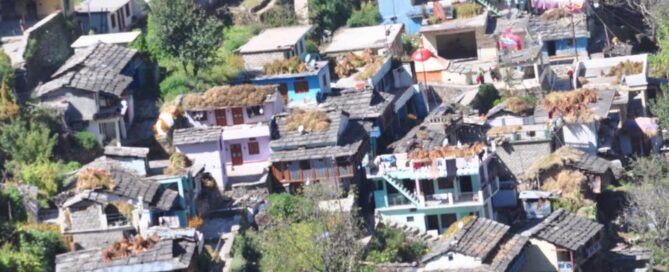In the month of October 2017 driving from Delhi to lower Lata village I came upon a story that defied imagination as a proud people who lived high up at 7900 feet had been stopped from entering the traditional grazing for their cattle.
I had travelled for five hours from Delhi to Haridwar from where the scenic road journey started, proceeding to Joshimath passing through Devprayag, Srinagar, Rudraprayag, Karanprayag and Chamoli. Enroute from Peepalkothi started the views of the Hathi and Ghori peaks.
Joshimath, over the years has become a crowded market place and so I did the next best thing which was driving 13 kms uphill to the scenic hamlet of Auli surrounded by peaks like Dunagiri, Bethartoli and Nanda Devi. Here the GMVN hotel provided the much needed rest after traveling 496 kms from Delhi which took me 14 hours.
From Joshimath to the road head of Lata village was a 25 kms ride which after leaving the sulphur springs of Tapovan was quite bumpy due unfinished road building, but on the whole the ride was smooth. Having contacted my friend on Facebook Sohan Bisht from Parsari village near Koshimath he got me to shop for vegetables and other rations needed for a trek from upper Lata village to Latakharak at 13000 feet. Sohan Bisht gave me a much needed contact called Raghubir Singh who was one of the finest guides of the Nanda Devi National Park, the greater core area containing the Sanctuary which now unluckily is banned from entry.
A gentleman with a wide grin from ear to ear put me and my companion at ease. Along with his son Prem, he carried our rucksacks and took us a km upwards from lower Lata to upper Lata at 7900 feet from sea level. Our departure for Latakharak was delayed as the son of Raghubir’s neighbour was getting wed and as weddings go in the mountains, the festivities would go on for a week. But he assured us we hadn’t to worry as he would take off after only two days of attendance! This stop to our plans did not mean we would lose money as we now had a small hut to live in his homestead complete with two cots and carpeted floor for my St Bernard boy Leo. Oh I forgot to mention my four legged trekking companion of six years of age who had been climbing the high alpine trails of the Western Himalayas ever since I retired from Air India in August 2015 starting with the Roopkund lake trek the very next month of September!
Attending the wedding meant I could photograph the guests in all their finery as these folks of mixed Aryan and Tibetan features had a culture which was very different from the plains men of Uttarakhand. Their women had a tunic threaded with gold embroidery and a long frock that went all the way to their feet shod in very pretty shoes. Now one thing made my inquisitive mind ask: “what were the shiny ivory-like white small horns hanging like pendants from their necklaces?” On enquiry I found those were the horns of musk deer which were once hunted for their scent glands, which are commonly used in perfumes. The glands can fetch up to $45,000/kg on the black market. It is rumoured that ancient royalty wore the scent and that also worked as an aphrodisiac.
The riches of a family were determined by how many of the horns a lady wore on her necklace. But now after the closure of the inner sanctum of the Nanda Devi National Park the hunting had got stopped.
By 1977 the environmental degradation was being documented, and in 1982 a 625 sq. km area surrounding the highest peak of India Nanda Devi was declared a national park and promptly closed to all people including locals. This was a blow to local people who had enjoyed a high standard of living previous to the closure. Since the 1930s foreign climbers have been flocking in to Lata village in order to climb this magical peak that the Garhwali people of Uttarakhand worship as the life giving divine mother. Due to pressures of the climbing expeditions that cut and burned shrubs and trees for fuel, the situation became untenable. Then occurred a terrible accident of losing a nuclear device on Nanda Devi in 1965 by the combined efforts of the CIA and Indian agencies. Finally, the Indian government had to take a call.
After the re-opening of the sanctuary in 1974 to foreign climbers, trekkers, and locals, the fragile ecosystem was soon compromised by firewood cutting, garbage, and grazing. Serious environmental problems were noted as early as 1977, and the sanctuary was closed again in 1983. Currently, Nanda Devi forms the core of the Nanda Devi National Park declared by the Indian government in 1982. In 1988, Nanda Devi National Park was declared a UNESCO heritage site. The entire sanctuary, and hence the main summit (and interior approaches to the nearby peaks), are now off-limits to locals and to climbing expeditions.

